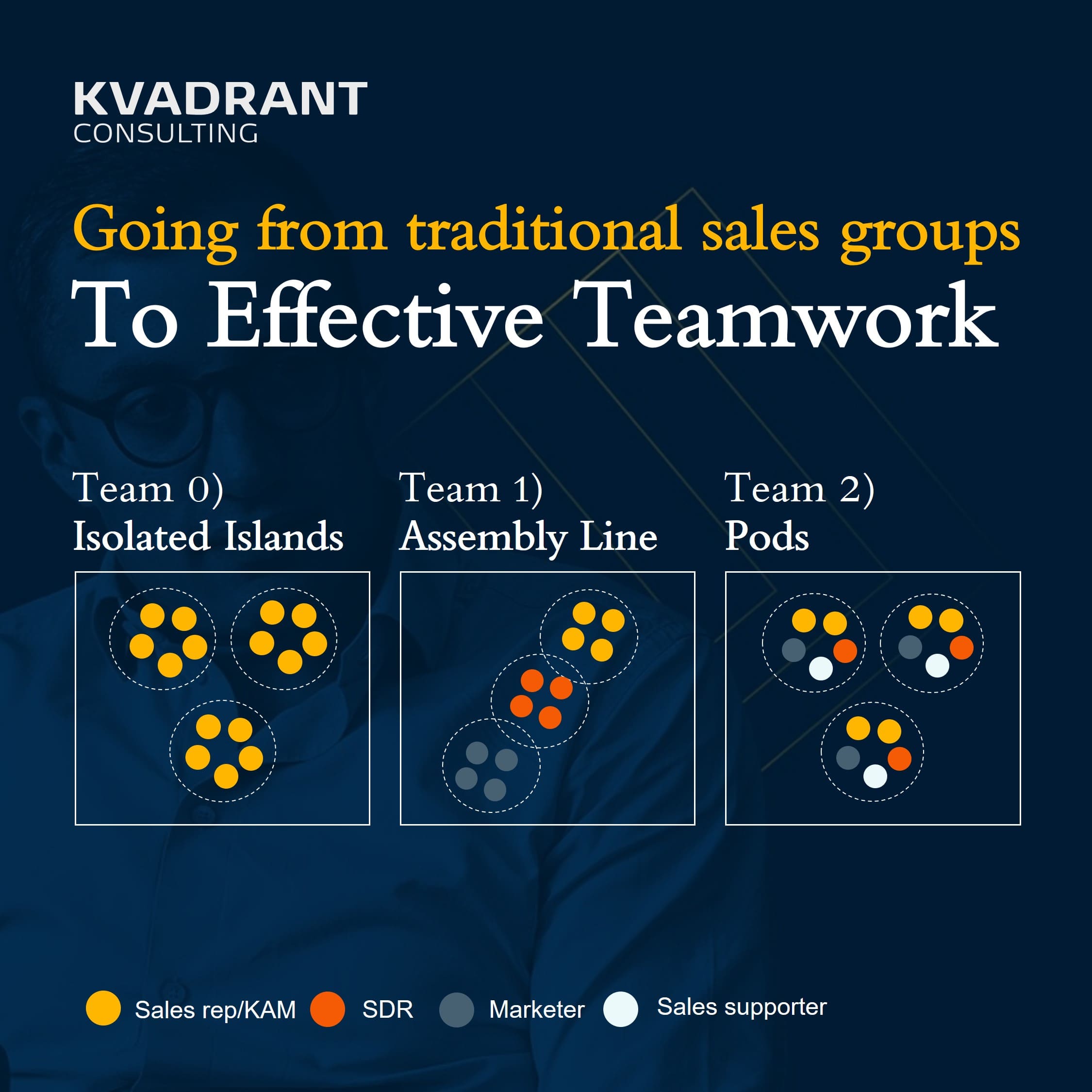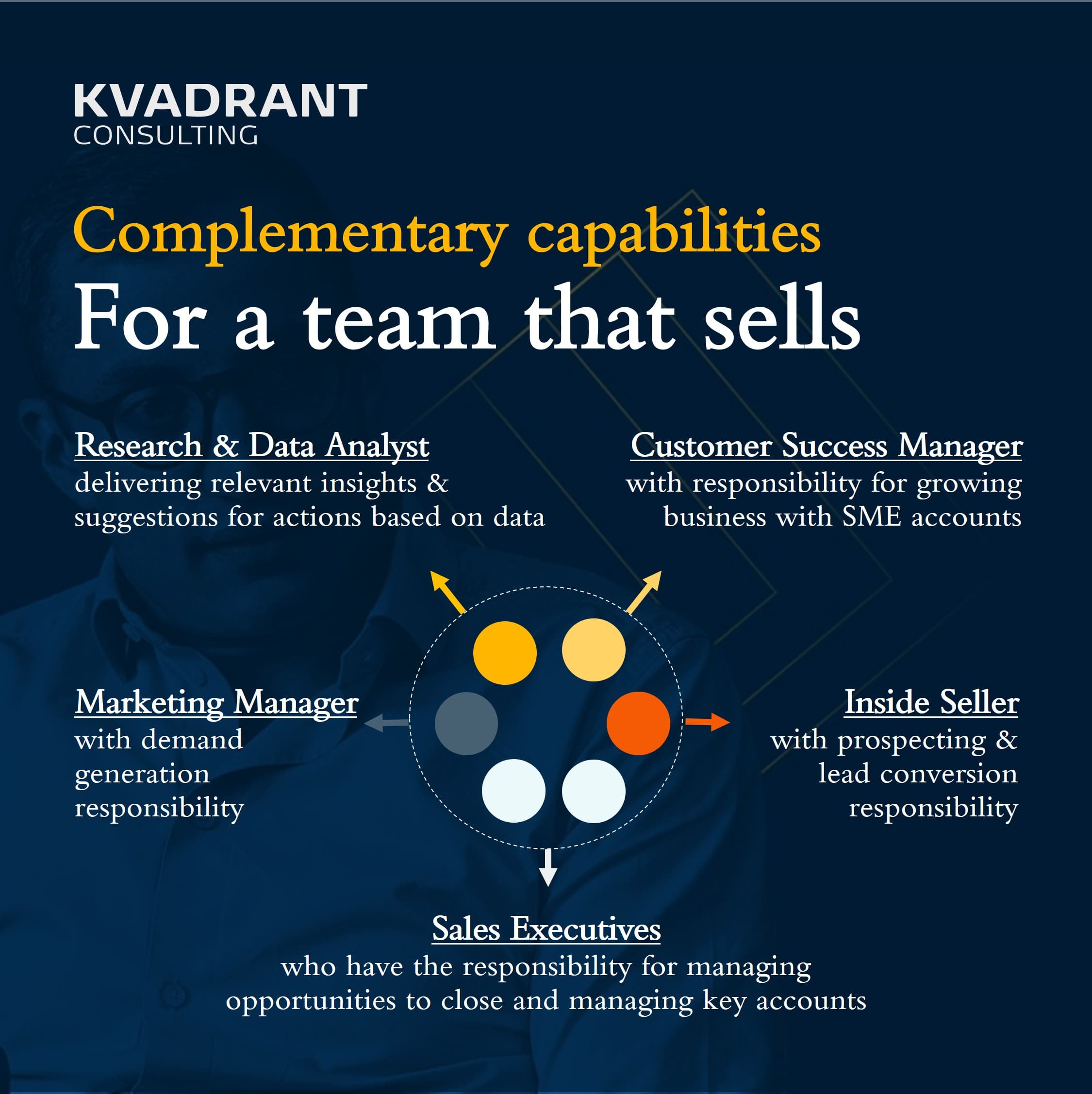Selling has never been easy but it used to be more simple; Less technology to master and data to interpret (CRM). Fewer channels for customer engagement (Phone, face, mail). Less-educated & informed buyers to engage with (power to the sellers).
But as new tech, data availability & channels for customer engagement has radically empowered sellers to sell more effectively, it has also made effective selling a much more complex task to succeed with.
Perhaps too complex a task for the traditional B2B sales team to succeed with?
Traditional B2B sales teams and the divide & conquer approach
Traditionally, B2B sales teams have consisted of 4-8 salespeople with similar characteristics and responsibilities, plus a sales manager. The team would cover an assigned segment (e.g. a country, regional, or industry vertical), which would then be carved into smaller parts and assigned to each individual team member together with an individual sales target (e.g. sales territories).
A classical divide and conquer strategy.
Although the titles on the team may have varied depending on the seniority of the individual members (Sales rep, account executive, Key Account Manager, Senior Key Account Manager, etc.), their individual responsibilities and tasks were more or less the same; Prospect for new opportunities on existing and potential customers in assigned territory, close deals and grow business with accounts in portfolio.
A sales team of individual salespeople with similar characteristics, responsibilities, and tasks, but working separately on different sales territories or account portfolios.
This “Isolated Islands” approach to setting sales teams was traditionally preferred by sales leaders for 3 reasons in particular.
1. Easy delegation of overall responsibilities to smaller individual responsibilities: Big areas are simply carved into smaller areas that are then given to individuals (Country sales target -> Regional team sales target > Individual sales area target)
2. Ease to manage: One idea about “what good looks like” to hire for and coach towards (“Star Performer” traits and behavior) and same type of sales manager interactions with all individual team members (Pipeline coaching, deal coaching, skills coaching).
3. Reasonable to expect individual salespeople to master it all: From analyzing the market to identify potential opportunities and prospecting for new customers to managing incoming orders and updating information into CRM. Individual salespeople could reasonably be expected to master the selling process end-to-end and supporting technology.
A simple and highly scalable way to grow sales and the sales organisation, which has stood the test of time until recently when it became neither reasonable not desireable to have every sellers do it all alone.

Are individuals or teams the best way to address new requirements for effective selling?
Technology adoption by both sales organizations and buyers has drastically moved the bar for what effective selling looks like.
– As buyers consume more content online, effective selling means creating and getting content to them.
– As buyers spend more time on social media like LinkedIn, effectively selling means engaging with them there.
– As buyers give contact information for high-value content or tools, effective selling means responding immediately to their interest.
– As buyers leave a greater digital footprint (data), effective selling means using that information to do the right things at the right times with the right people.
– As buyers start working more remotely, effective selling means being able to engage with buyers through virtual sales meetings.
– As sales technology matures, effective selling means taking advantage of new digital tools to get more done in less time (efficiency) and continuously doing it better than before (effectiveness)
The bar for what effective selling means is essentially moving higher and higher with new disciplines, technology, and activities to master to stay ahead of the game (or just keep up with it).
For the sales leader responsible for ensuring that his or her sales organization is equipped to win, that development brings forward a fundamental question about what to do with these new requirements for effective selling today:
A. Get each individual seller to be able to do more? (Strengthen the individual island) Or,
B. Get the sales team to be able to do more as a whole? (Strengthen the team)
Solve the challenge of increased requirements for effective selling through a focus on the individual or the team?
As the requirements for effective selling grows, we need to work with sales like a football team, rather than a team of individual performers
Imagine you are the sales director of a typical B2B industrial manufacturer company (selling +€50k solutions to +5 person buying committees in 3-12 month sales processes), and you have been tasked with growing sales to a new industry vertical in your region.
You have asked for -and received a budget to hire a sales team of six people + a manager, and are considering 2 different options:
Team 1 – Team of sellers: 6 salespeople with similar capabilities, doing the same thing but separately in their individually designated territories (research, prospecting, social selling, interest creation, opportunity management, account management, etc.).
Team 2 – Team that sells: 6 people with complementary capabilities working together to sell.
- 1 research & data analyst delivering relevant insights & suggestions for actions based on data
- 1 Marketing Manager with Demand generation responsibility
- 1 Inside seller with prospecting & lead conversion responsibility
- 2 Sales Executives with responsibility for managing opportunities to close and managing key accounts.
- 1 Customer Success Manager with responsibility for growing business with SME accounts
Back when sales was a difficult but more simple game, sales leaders might have done well in hiring the best sales generalists to execute all activities individually, from research & prospecting to closing & managing accounts. A team of individuals.
But as the game of effective selling has become a more complex one, the need for sales teams to develop specialist roles that collaborate to win is growing and so is the need for sales leaders to create teams that sell rather than teams of individual sellers.
Rather than looking at the members of sales teams as individual “athletes” that need to be developed & managed for peak individual performance, sales leaders need to look at how the team as a working group is best developed & managed for peak team performance.
A football team with only strikers does not win. Those able to combine different specialist roles (goalie, defender, midfielder, striker, coach, etc.) and get them to collaborate do.

How to take sales effectiveness to the next level by making selling a team discipline
As with most transformations, it is better to start small to test the effect for your specific company and the selling environment you operate in. No need to restructure your entire salesforce, but start with this instead
1. Identify a specific target segment that you would like to give a sales team end-to-end responsibility for driving sales growth with (e.g. Small hospitals in Bavaria)
2. Select a team leader, to make responsible for the “experiment”, and explain your ambition to see what results from a collaborating “team that sells” is capable of delivering.
3. Decide with the team leader which 4-6 “specialists” to build the team around and hire these from within the company or externally (e.g. 1 Data analyst, 1 Marketing Manager, 1 Inside Seller, and 2 Consultative Sellers)
4. Align team members around a clear understanding of shared purpose, individual areas of responsibility, and the team’s shared operating rhythm (e.g. daily 5 min morning check-ins, weekly team pipeline & performance meetings, monthly team developments sessions, etc.)
5. Put the team to play and implement frequent evaluation and calibration in the first few months. No winning teams excel from the start but all teams need to learn to play as one to win.
Making selling a team discipline is not only the right things to do from a sales effectiveness perspective. All of us who have tried to sell both as a “lone wolf” and as a true team effort know it is also a more engaging way to work that brings a higher degree of personal and professional satisfaction.









